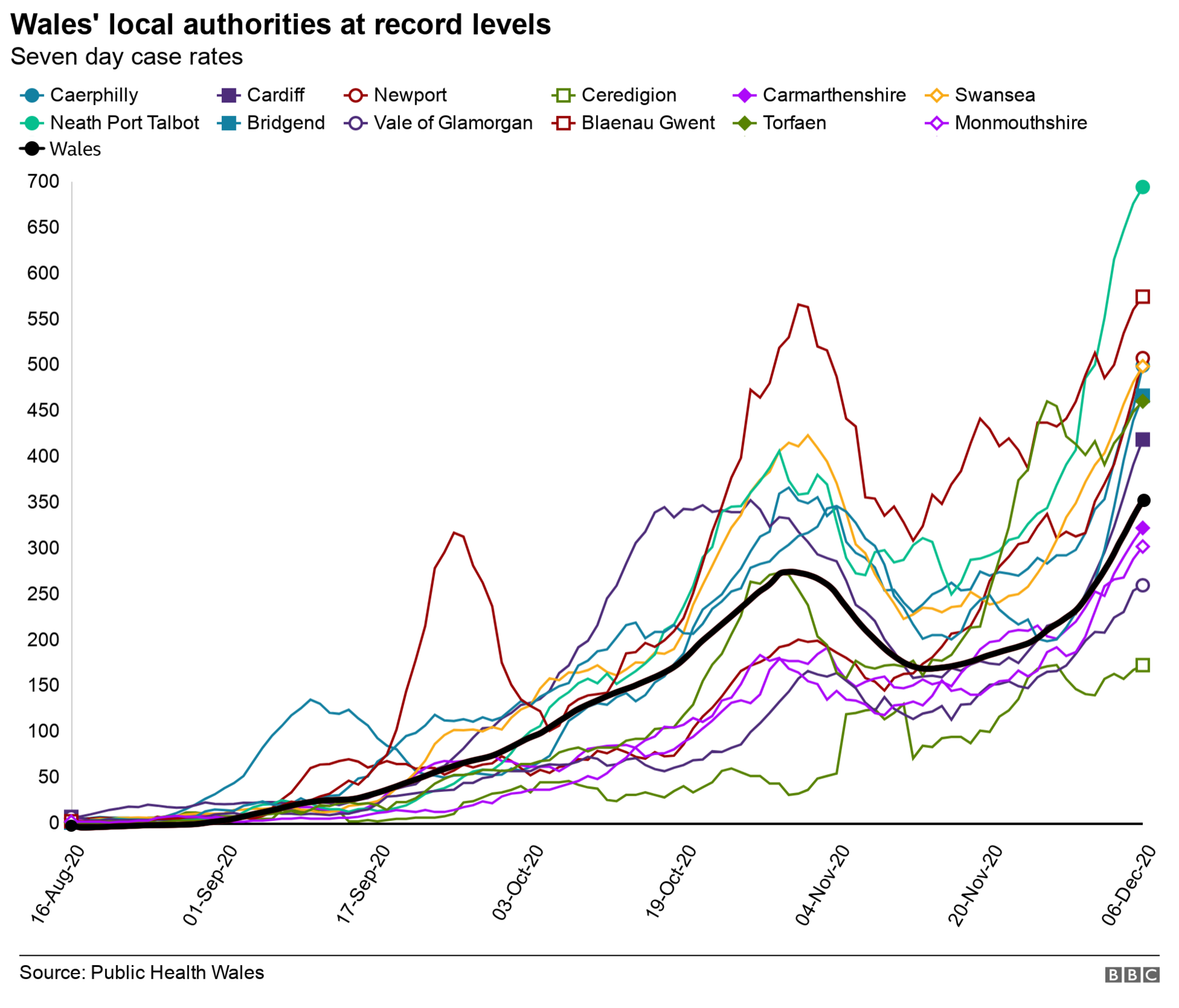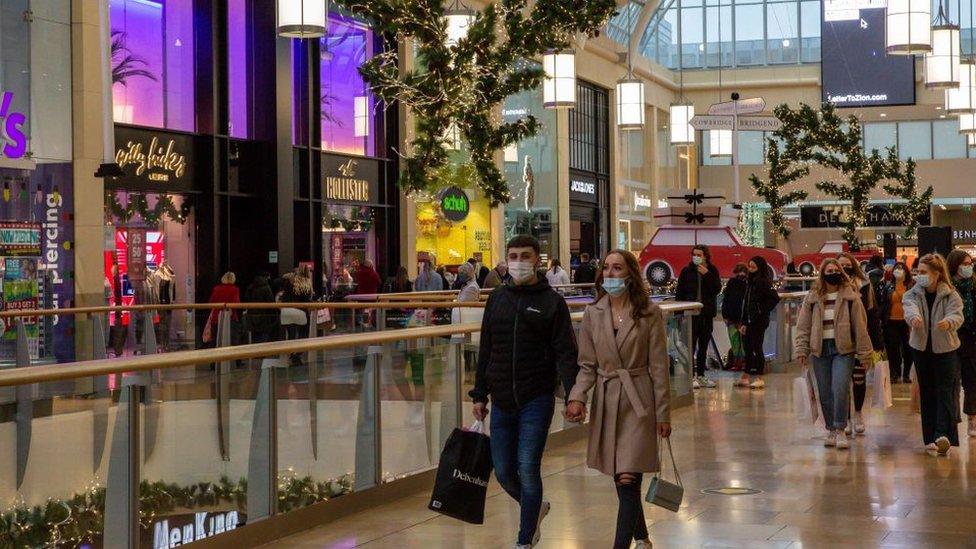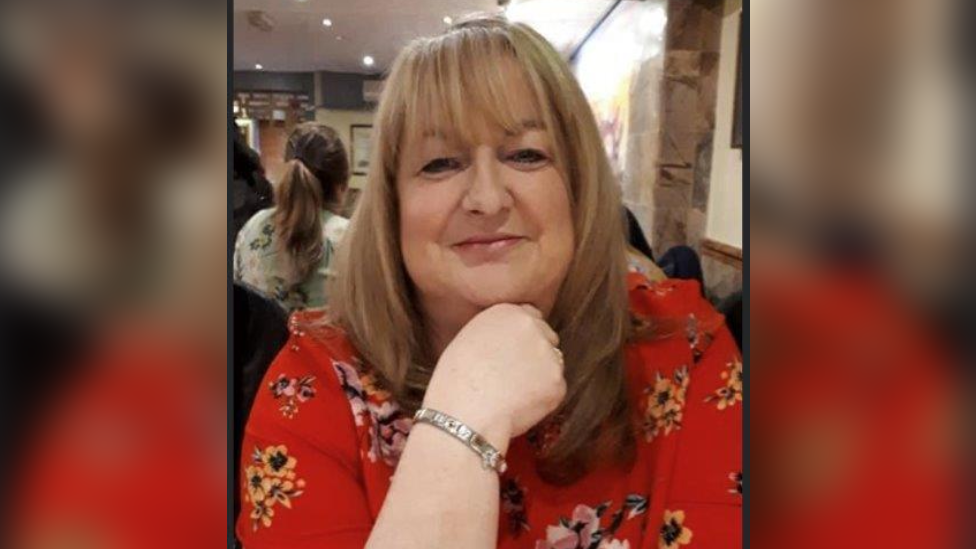Covid in Wales: Record high case rates in half of council areas
- Published
- comments
'Don't mix' outside your household bubble was the message from Dr Frank Atherton
Case rates in more than half of council areas have hit their highest levels yet, according to latest figures from Public Health Wales.
Neath Port Talbot - with 693.6 cases per 100,000 in the last week - is the highest in Wales.
But 11 other local areas from Ceredigion to Monmouthshire are also at their peak for positive cases.
It follows a warning from Wales' chief medical officer not to mix with people outside your household up to Christmas.
Dr Frank Atherton told a Welsh Government briefing: "The best present we can give our families this year is a coronavirus-free Christmas."
Groups of four people from different households are allowed to meet indoors at pubs, cafes and restaurants.
Previously the Welsh Government has said people should limit themselves to seeing the same "one or two friends".
The rule of four also applies when meeting people from different households outdoors, away from your home, but meeting anyone from outside your household bubble in someone's garden is not allowed.
Two families can form an extended household and these are the only people allowed to mix inside a home.
The case rate for Wales as a whole has also now reached its highest point yet - 351.5 cases per 100,000 people in the last seven days.

What do the latest figures tell us?
Neath Port Talbot still has the highest case rate in Wales but it has risen sharply to 693.6 per 100,000.
In recent days, according to comparable figures, it has had the worst case rate in the UK.
Seven of its communities are in the highest 20 places for localised case rates in Wales, with Aberdulais and Resolven the second highest in Wales on 1,418 cases per 100,000 with 97 positive tests in the past week.
The county is also one of four council areas with positivity rates above 20%.
The World Health Organisation has recommended the positivity proportion of tests should be no more than 5% before areas come out of restrictions.
Public health officials have already warned Covid rates could soon reach "catastrophic levels" unless people in the Swansea Bay area followed the rules on social distancing over Christmas.
Caerau, near Maesteg, has the highest localised case rate - 1,779.9 per 100,000 - for the past seven days, with 126 cases. The wider Bridgend county has also reached its highest case rate.
Newport, with its case rate increasing rapidly and beyond 500, is another which has reached its highest case rate yet, while Cardiff passed 400 cases per 100,000 for the first time.
Although comparatively lower, Ceredigion, Carmarthenshire and Monmouthshire are among others witnessing their highest rates since the pandemic began.
'Don't mix if you can avoid it'
Up to 15 people can take part in activities indoors and up to 30 outdoors - providing social distancing, hand hygiene and other Covid safety measures are followed.
"Covid thrives on human contact," Dr Atherton said.
"We all have to work to reduce the number of people we have contact with between now and Christmas.
"My message on this is really very simple - don't mix with people outside your household between now and Christmas."

Four people from different households in Wales are currently allowed to meet indoors at pubs, cafes and restaurants and outdoors
He said he had cancelled his own plans to visit family in Northern Ireland when it comes out of lockdown and also plans to see his children in England.
"My main priority is to keep my whole family safe and healthy," he said.
"The best way I can do that is to stay at home and have a small Christmas this year".
He added that he wouldn't be going out to pubs, restaurants and Christmas fairs in the run up to the holiday.
When asked about introducing further restrictions before the festive period, he said ministers were considering "what further things might be possible in the run up to Christmas", adding "that needs to be considered".
"We also need to think about the Christmas period - managing our risks to make it as low as possible during that five days," he said.
Dr Atherton told journalists there had been some expectation from the Welsh Government that the public in Wales would limit mixing after the firebreak had ended, but that had "not happened as anticipated".
He added: "That's probably understandable given people's enthusiasm to start to think about Christmas, given the tiredness of everybody because of what's happened over the last few months."
On Tuesday, Welsh Government advisers said the number of people in Wales dying with the virus was above the worst case scenario.
Prior to the firebreak, it was projected under Swansea University's reasonable worse case scenario model that 6,000 people could die by March, but a new model has been commissioned which has not yet been published.
Mr Atherton said present transmission levels were above what the Welsh Government had expected.
"We are at risk of getting into the Christmas period with much higher rates than we had anticipated or had hoped," he said.
- Published9 December 2020

- Published9 December 2020

- Published3 November 2020

- Published30 November 2020
